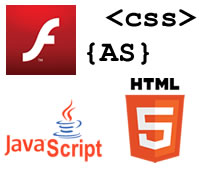
It’s a loaded question, isn’t it? The kind of attention grabbing headline we’ve come to expect from the mainstream media who receive a substantial portion of the $691,000,000 (2010) of Apple Inc.’s annual marketing budget. So what of this epic struggle between Adobe’s flagship software platform and the open source, open standard HTML5?
Some sobering facts
- HTML was born* in 1995.
- Javascript was also born in 1995.
- CSS was born in 1996.
- Flash was born in 1997.
* By “born” I mean the first working versions of the respective languages and runtimes were released to the public, i.e. HTML 2.0 and Flash Player 2.0.
So none of them are new and they all get significant new features added to them from time to time. HTML, CSS, Javascript and Flash have co-existed, collaborated and integrated with each other for the past 14 or so years. They’ve done very well together and if we took any one of them away, the WWW would be a poorer place for it. They all have their merits:
- HTML is open specification and great for flexibility and accessibility. HTML text flows naturally across the screen, browsers can apply anti-aliasing to make it smoother on the eye, the text can be resized (Ctrl + mouse wheel) which is perfect for the sight-impaired, assistive technologies can convert the text to speech for accessibility, etc. In short HTML is wonderful for everyone.
- CSS (Cascading Style Sheet) defines the physical appearance (look and formatting) of web pages, for example defining text fonts, sizes, colours and styles, the arrangement of areas of text, images and other elements on the page.
- Javascript is a flexible, open format, object oriented scripting language that runs natively in web browsers. It adds interactivity to web pages transforming static, inert HTML elements into interactive objects that respond to users’ actions. Since 2000, Javascript has also been commonly used in elearning SCOs, e.g. Adobe Captivate, Articulate and Raptivity, to relay data from Flash applications to Learning Management Systems’ SCORM modules. It’s now becoming more widespread with the introduction of code libraries such as JQuery and MooTools which make programming with Javascript’s idiosyncrasies much easier.
- Flash and its native programming language, Actionscript, provide the whiz-bang wow factor on the WWW. Its role has always been to do the things that web developers couldn’t and can’t currently do on the WWW with HTML, CSS and Javascript alone or where it is impractical to do so. Its primary rise to internet fame was in providing a platform to display scaleable vector graphics (SVG) and animation in web browsers, i.e. images that move and don’t get pixelated when you expand or zoom them. Shortly after that it provided support for sound and then video. Before Flash Player supported video, it was possible to play video on web pages with other plugins like Apple Quicktime, Windows Media Player and Real Networks Real Player. However, they all used different, proprietary video formats that weren’t cross-compatible (See Youtube API Blog link below). Flash Player is currently the only way to do web conferencing with access to webcam and microphone in a browser. The most recent version of Flash Player (11) introduces 3D graphics engines and GPU hardware acceleration: http://away3d.com/
In short, they’ve all had a long and productive history together and they’ve all contributed to making the web a richer, more enaging, more accessible medium. At one time or another, they’ve all had their critics and predictions of their demise. Will HTML5 kill Flash? More likely, HTML5 will gradually replace HTML4 and some but not all of what Flash currently does. No killers, no victims and not very sensational after all.